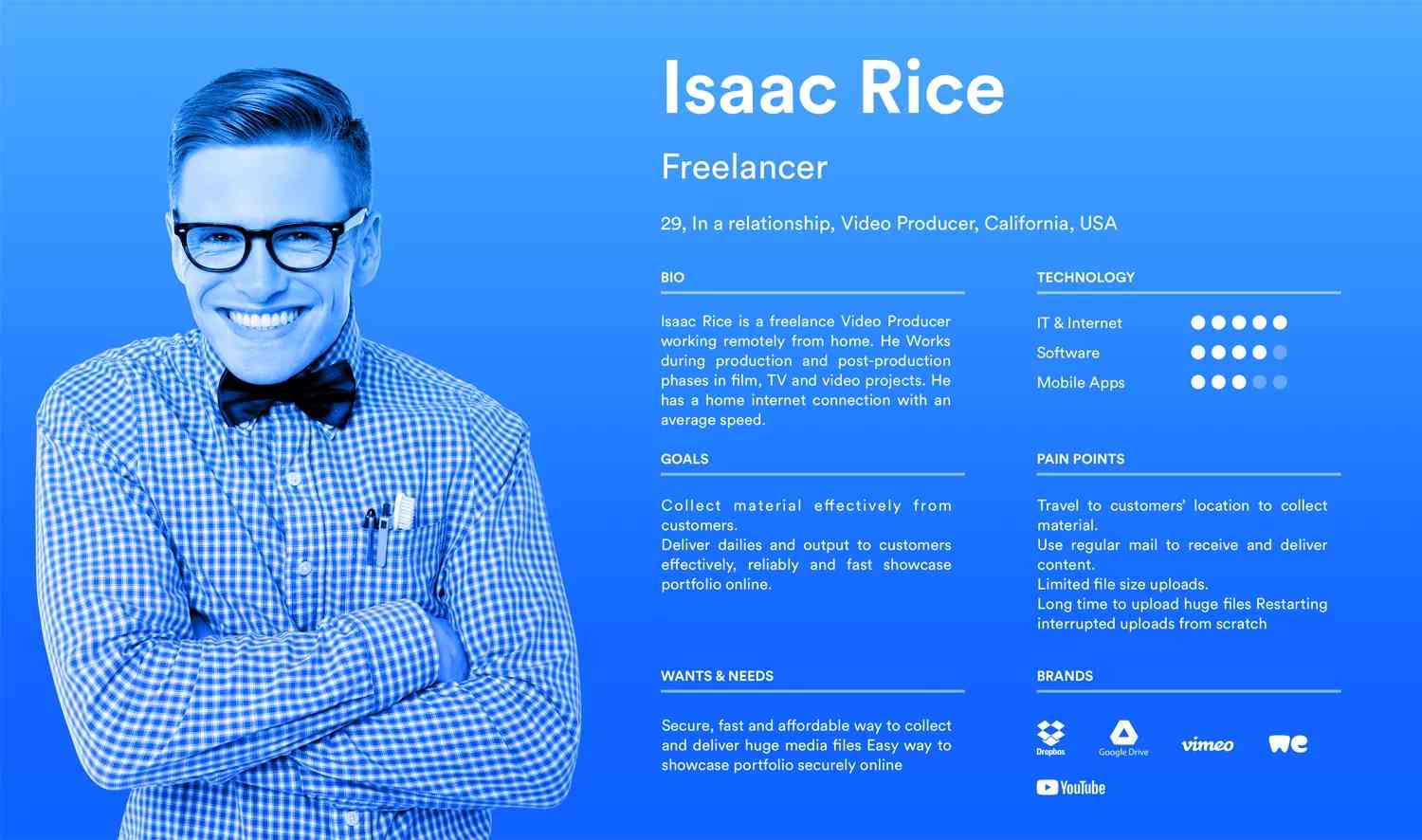How to Create Customer Personas (With AI Prompts)

As a marketing manager, you can do a better job targeting your audience by creating customer personas, a kind of “shorthand” for visualizing your target customer. Here’s how to make the customer persona process faster using our Customer Persona Generator.
How to Use Our Customer Persona Generator
Just answer a few questions about your business or product, and fill in as much as you know about your target customer. Our AI Customer Persona Generator will take care of the rest.
Remember: the more information you give it, the better your customer persona will get. You can keep refining it until you’re happy with the results — then have the final customer persona emailed to you.
AI Prompts for Creating Customer Personas
Once you’ve drafted your customer persona using our tool above, here are further prompts that you can use to polish and perfect your customer persona:
To enhance demographic details: Expand on the demographic attributes of our target audience, including age, gender, location, and occupation.
To refine pain points: Elaborate on the key challenges and pain points our customers commonly face daily.
To elevate goals and aspirations: Describe the primary goals and aspirations that drive our customers, highlighting both short-term and long-term objectives.
To amplify hobbies and interests: Provide a comprehensive list of hobbies, interests, and leisure activities that resonate with our audience.
To deepen emotional triggers: Explore the emotional triggers that influence our customers’ decision-making process, focusing on fears, desires, and motivations.
To enrich brand preferences: Detail the brands, influencers, or thought leaders that our customers admire and follow, and explain the reasons behind their preferences.
To expand media consumption: Outline the types of media our customers consume regularly, such as books, podcasts, blogs, and social media platforms.
To diversify communication channels: Suggest innovative communication channels and platforms where our customers are likely to engage beyond the conventional ones.
To provide purchase behavior insights: Analyze the factors contributing to our customers’ purchasing decisions, including budget considerations and decision-making influencers.
To cultivate online behavior: Describe how our customers behave digitally, including online shopping habits, browsing patterns, and social interactions.

What is a Customer Persona?
A customer persona is a brief document that outlines your target customer: it explains their demographics, psychographics, behavior, and pain points. Typically, these take the form of one or more “sample customers.” These documents are sometimes called customer personas, buyer personas, or customer avatars.
Gathering the Data
The first step in persona development is gathering the data in two parts.
Quantitative data will tell you a lot about your current customers. You can use sources such as:
- CRM Data: Customer Relationship Management systems provide information about existing customers – their industries, job roles, purchasing history, engagement patterns, and more.
- Website Analytics: Tools like Google Analytics can reveal which pages are visited most often, the demographic details of visitors, how long they stay on the site, and their journey through the site.
- Social Media Analytics: Platforms like LinkedIn, Facebook, and X provide analytics that can help understand the demographics and psychographics of your audience. (For B2B marketers, LinkedIn is of primary interest.)
- Email Campaign Data: Analysis of who is opening, reading, and clicking through emails can give clues about the types of content that resonate with different segments of your audience.
- Competitor Analysis: These data sources can highlight where your company is stronger or weaker than the competition.
Qualitative research complements your quantitative data, adding depth to your analysis. We highly recommend:
- Customer Surveys and Interviews: Getting direct feedback from current customers through surveys, interviews, or focus groups is our #1 recommendation: you’ll hear things that you won’t ever hear inside the company.
- Sales Team Feedback: Getting direct input from the sales team can offer insights into the common questions, concerns, and preferences of prospects and customers.
- Feedback from Customer Support: Researching customer service interactions can highlight common issues, questions, or user feedback, offering a direct line into customer needs and satisfaction.
- Market Research Reports: Reading industry-specific reports can offer broader insights into market trends, challenges, and opportunities relevant to your customers.
- Online Forums and Communities: Visiting places where potential customers might discuss their challenges or seek answers can be invaluable: think Reddit, Quora, specialized industry forums, or LinkedIn groups.
Marketer’s Takeaway: Customer personas are based on real data, showing actual customer demographics and purchasing behaviors. Your primary quantitative data sources will most likely be your ecommerce, email marketing, social media, and CRM platforms, whereas qualitative data comes from talking with (and listening to!) your customers.
Segmenting Your Personas
How many customer personas should you create? The rule of thumb is to keep it simple.
According to MarketSplash, 90% of reported company sales are through 3-4 distinct customer personas. (You can probably get by with fewer.) The more personas you create, the harder it will be for your team to remember them all. And most of your business usually comes from just a single customer persona: that’s the most important one.
Once you’ve pulled your data, the real work begins: develop a “model” that represents that core customer. Some questions you can answer:
- Demographics: What does your target customer look like? Age? Gender? Income level? Education? Location?
- Job Titles: What job titles do they typically hold? In what companies? In what industries?
- Psychographics: What are their interests and hobbies? What values and beliefs might influence their purchasing decisions?
- Media Consumption: Which platforms do they use most often (social media, blogs, newspapers, etc.)? What type of content do they consume?
- Pain Points: What problems or challenges could your product or service solve for them?
- Buying Motivations: What drives their purchasing decisions? Are they more influenced by price, quality, brand reputation, or peer recommendations?
- Decision-Making Process: How do they typically make purchasing decisions? Who else might influence these decisions?
- Customer Journey: What is their typical journey from becoming aware of your product to purchasing?
- Goals and Aspirations: What are their personal or professional goals, and how might your product or service help them achieve these?
- Preferred Communication Channels: How do they prefer to be contacted by brands (email, social media, phone, etc.)?
Marketer’s Takeaway: Developing customer personas involves simplifying all the qualitative and quantitative data into a “story,” or a model, that can be used to visualize your most important customer segments. It takes a little imagination and a lot of simplification. Eventually, you want something like the examples below.
Customer Persona Examples
Example Company: NexaPoint Tech
Here’s a sample customer persona for a fictional company called NexaPoint Tech, creators of NexaShield Dashboard, a network management and security solution. We’ve analyzed market trends, customer feedback, sales data, and user data from our digital platforms to construct these personas. The insights were further enriched by feedback from our hypothetical sales and customer service teams, who interact directly with clients.
Persona: Enterprise ErinSegment: High-level Decision Maker
Profile: Erin is a CTO in a large enterprise, likely in finance or healthcare.
Goals: She seeks robust, scalable solutions ensuring network security and industry regulations compliance.
Challenges: Erin is concerned with managing complex networks securely and meeting stringent compliance standards like GDPR or HIPAA.
Engagement: Prefers detailed, informative content like whitepapers and case studies. Likely to engage through LinkedIn and industry events.
Persona: IT Manager Mike
Segment: Mid-level Technical Manager
Profile: Mike manages the IT department in a mid-sized company, possibly in government support or logistics.
Goals: Focuses on efficient network management, cost-effective solutions, and minimizing downtime.
Challenges: Struggles with balancing budget constraints with the need for advanced network security.
Engagement: Responsive to how-to guides, webinars, and practical demonstrations. Active on professional forums and LinkedIn.
Persona: Startup Sarah
Segment: Emerging Business Leader
Profile: Sarah is a tech-savvy startup founder who needs agile and flexible network solutions.
Goals: Seeks scalable, user-friendly, and cost-effective network management tools.
Challenges: Limited resources and a lack of dedicated IT staff. Needs solutions that are easy to deploy and manage.
Engagement: Engages with dynamic and concise content like infographics, blogs, and interactive tools. Active on social media platforms.
Company: Bibliocafe, LTD.
To construct customer personas for Bibliocafé Ltd., we blend market research, customer behavior analytics, and demographic studies. These personas are based on a combination of real customer data (from similar business models) and hypothetical scenarios that align with the unique dual offering of books and coffee. By analyzing purchasing patterns, online engagement, and in-store interactions, these personas are crafted to represent the most likely customer segments for Bibliocafé Ltd. The goal is to utilize these personas in tailoring marketing strategies, product offerings, and customer experiences.
Persona: Curious CarolineSegment: Young Professionals
Profile: Caroline, aged 28, is a young professional working in a nearby tech startup. She values intellectually stimulating environments and often seeks a quiet but inspiring place to relax after work or on weekends. She’s an avid reader, with a keen interest in both contemporary fiction and self-development books. Caroline enjoys the ambiance of a café where she can unwind with a good book and a carefully crafted latte. Social media savvy, she often shares her reading spots and favorite books online.
Persona: Book Club Bob
Segment: Book Club Enthusiasts
Description: Bob, in his mid-50s, is an active member of a local book club. He prefers physical books over e-books and values discussions and community events centered around reading. Bob visits Bibliocafé Ltd. for its wide selection of genres and the possibility of discovering new authors. He often participates in book readings and signings and is always on the lookout for interesting picks for his next book club meeting. Bob appreciates a warm, inviting atmosphere where he can engage in lively discussions over a cup of medium roast coffee.
Persona: Student Sarah
Segment: College Students
Description: Sarah, a 22-year-old college student, frequents Bibliocafé Ltd. as a study spot and a place to find academic resources. She’s budget-conscious but willing to spend on quality coffee and snacks. Sarah is a digital native, heavily reliant on her laptop and free Wi-Fi. Still, she also enjoys the tactile feel of reading physical books, especially classic literature and modern thrillers. She’s drawn to Bibliocafé Ltd. for its study-friendly environment, range of affordable used books, and location, which is convenient from her campus.
Each persona represents a key segment of Bibliocafé Ltd.’s target market. “Curious Caroline” embodies the young and intellectually driven professionals, “Book Club Bob” represents older, community-focused readers, and “Student Sarah” captures the student demographic seeking a comfortable study environment. Understanding these personas helps craft tailored marketing strategies and enhance customer experience.
Visual Examples of Personas
Sometimes, it helps to have a comprehensive, visually-oriented persona (or list of personas) that you can include in brand guides and marketing materials. These help your internal teams quickly skim and understand important information about those personas and allow you to incorporate visual elements into the persona.
Isaac Rice – Freelancer

This example, courtesy of UserGuiding.com, demonstrates how you can use color, design, and non-written elements to bring a persona to life. This makes the persona seem more like a real person who could exist rather than a fictional character in a book. It also provides skimmable content (note the dot-scales under “Technology”) that makes it easier to understand who they are and how they fit into your overall campaign efforts.
Lisa Montoya

This example from venngage.com provides even more visual appeal that streamlines persona development. Written elements are minimal, but the use of visual ranges and icons helps you understand exactly what this persona is all about–and, more importantly, what is important for the organization and their marketing efforts (in this case, the persona’s outgoing nature, perception of their world, and how they navigate buying and shopping).
Future Trends in Customer Personas
Consumer behavior is constantly changing, meaning we marketers must embrace trends that redefine how we understand and engage with our audience.
- Artificial Intelligence and Machine Learning Integration: The future of persona creation will be heavily influenced by integration with AI and machine learning. AI algorithms’ ability to quickly analyze large amounts of customer data will continue to help companies offer better personalization. AI- and ML-powered chatbots will interact with consumers increasingly humanly, offering improved customer service.
- Using Insights From Data Gathering and Internet of Things: The advent of IoT–a network of the interconnected devices most people use, from cell phones to wireless-enabled cars that share data–has altered the face of data gathering, as it provides numerous real-time insights into customer behaviors. The combination of persona creation and IoT-driven data lets businesses capture customer interactions, resulting in more responsive personas that better reflect the consumer landscape.
- Using Predictive Persona Modeling: In the coming years, predictive persona modeling will likely become an even more powerful marketing tool. Companies can anticipate future customer behaviors using historical data, machine learning algorithms, and advanced analytics.
Many companies are already doing it. Audio streaming service Spotify uses predictive analytics to suggest music based on customer listening habits. Google incorporates predictive persona modeling in its search engine, and YouTube to tailor search results.
- The Omnichannel Experience: As consumer interactions span across ever more touchpoints, personas will play a greater role in unifying and personalizing the experiences. Increasingly, businesses will create personas beyond individual channels and platforms to guarantee a cohesive brand experience for customers at all stages of the buyer journey.
(This makes the below bespoke-mall-ads scene in “Minority Report” seem less farfetched.)
Marketer’s Takeaway: Experiment with AI and IoT to create responsive personas, and try predictive modeling to make proactive persona adjustments. The personas you create will be pivotal in unifying users’ omnichannel experiences so they have a cohesive brand journey.
Ethical Considerations
Adhering to these best practices will ensure your strategies are ethical, inclusive, and responsible.
- Data Collection and Privacy Concerns: Focusing on privacy will help you comply with regulations such as the European Union’s General Data Protection Regulation. It will also make certain that you uphold ethical data-collection practices.
How other companies are already doing it: To comply with the GDPR and other privacy regulations, many are implementing transparent data-collection practices, obtaining explicit user consent to use data, and offering easily accessible options for customers to manage and control their data. - Steering Around Stereotypes: Be aware of biases and stereotypes. Ensure inclusivity by crafting personas that reflect the diverse characteristics of your target audience. Staying away from preconceived notions will help your marketing strategies resonate authentically and respectfully with all customers.
How other companies are already doing it: To make sure they stay away from inadvertent stereotyping, businesses are actively seeking input from diverse ranges of customers and continually reassessing and refining their customer personas based on that feedback. - Keeping Ethical Standards High: To maintain high ethical standards, businesses should prioritize customer privacy, respect audience preferences, and use personas for worthwhile engagement. Upholding ethical standards will keep your brand’s reputation intact and help you build lasting customer relationships.
How other companies are already doing it: Maintaining transparent-as-feasible data practices is helping businesses keep their ethical standards high. This includes clearly communicating to customers their data-collection methods, purposes and usage policies and offering straight-forward opt-in and opt-out mechanisms.
Marketer’s Takeaway: Uphold ethical standards in customer-avatar creation by prioritizing privacy, avoiding stereotypes, and ensuring inclusivity. This will help you resonate authentically with diverse audiences and build lasting customer relationships.
Marketer’s Takeaway
Without customer personas, marketing can feel like shouting into a dark room. With customer personas, you have a clear picture of your target customer. That’s well worth the effort.
___________________
Could your marketing strategies use a boost? Take Media Shower for a test drive and see what we can do for you.


